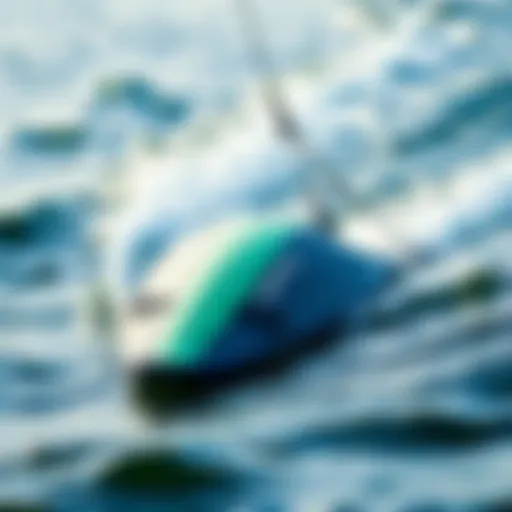Comprehensive Guide to Kite Board Kits for All Levels


Intro
Kiteboarding, often described as a fusion of surfing, windsurfing, and paragliding, offers thrill-seekers an exhilarating ride on water powered only by the wind. For those diving into this sport, understanding the components of kite board kits is paramount. As the sport grows, so does the market with an array of equipment tailored for all levels, from rookies learning the ropes to veterans perfecting their flips.
Choosing the right kit provides pivotal support in your kiteboarding journey. A well-chosen kit not only enhances performance but also ensures safety, a critical factor in a sport that relies heavily on weather conditions and user skill. In this exploration, we’ll break down various kit components, share tips on assembly and maintenance, and guide you in making informed decisions that align with your kiteboarding aspirations.
With the right gear in hand, the world of kiteboarding opens up, promising adventure across azure waters, sweeping landscapes, and golden sunsets. Let’s unravel the essentials together.
Intro to Kite Board Kits
Kiteboarding, with its blend of adrenaline and art, has surged in popularity over recent years. Central to this exhilarating sport is the kite board kit, which not only enables participation but also elevates the overall experience on the water. For both amateurs dipping their toes in for the first time and seasoned pros looking to refine their gear, understanding the basics of kite board kits is akin to knowing the ropes in sailing—a necessity for any enthusiast looking to ride the waves effectively and safely.
In this section, we’ll explore what exactly kite board kits are and their pivotal role in kiteboarding. Equipped with this knowledge, riders can make informed decisions when selecting their gear, ultimately improving their performance and enjoyment while navigating the wind and waves.
Definition and Purpose
A kite board kit typically consists of a kite, a board, control bars, lines, and various accessories designed to enhance the riding experience. Fundamentally, the purpose of a kite board kit is to provide all essential components that allow an individual to harness wind energy for propulsion. By inflating a kite and attaching it to a board, riders are able to glide over water at remarkable speeds, performing tricks and maneuvers that showcase their skills.
From inflatable kites that offer ease of use for beginners to specialized boards that cater to different riding styles, each component within a kite board kit serves a distinct purpose. This tailored setup enables riders to adapt to diverse conditions and personal preferences, offering a versatile approach to kiteboarding.
Importance in Kiteboarding
The significance of kite board kits extends beyond mere accessibility. They are fundamental to the sport's safety and performance. An ill-chosen kite or mismatched board can lead to a challenging and potentially hazardous experience for riders.
Key points to consider include:
- Safety: Quality kits come with built-in safety features to prevent accidents, such as quick-release systems that allow for immediate disconnection from the kite in emergency situations.
- Performance: A well-matched kite and board combination can enhance control and maneuverability, making it easier to execute complex tricks or navigate turbulent waters.
- Personalization: Different riding styles call for different gear setups. A freestyle rider might opt for a different board compared to someone focused on racing. Understanding which components enhance one's style is vital.
- Environmental Adaptation: Selecting the appropriate kite board kit for specific wind and water conditions is key. This ensures optimal performance without risking equipment damage or personal injury.
Understanding kite board kits not only equips riders with the knowledge to choose wisely but also fosters a deeper appreciation for the intricacies of this dynamic sport. Each session on the water will be richer, informed by the right equipment selections.
Components of a Kite Board Kit
Understanding the components of a kite board kit is crucial for anyone interested in kiteboarding. Each part plays a key role in enhancing the overall experience, ensuring safety, and maximizing performance on the water. A kiteboard kit typically includes kites, boards, control bars, lines, and leashes, each having unique characteristics and specifications that cater to varying skill levels and environmental conditions. By familiarizing oneself with these elements, kiteboarders can make informed choices tailored to their needs, ultimately leading to a more enjoyable time on the water.
Kite Types
Inflatable Kites
Inflatable kites stand out due to their design, which features inflatable chambers that provide buoyancy. These kites are well-regarded for their ability to launch easily and stay stable in the air, making them a favored option for newbies and seasoned riders alike. Their lightweight structure and larger surface area offer better performance in lower winds, making them an excellent choice for diverse riding conditions.
One of their main perks is the safety factor; when let go, inflatable kites tend to fall gently on the water, minimizing potential damage. However, they require regular inspection and can be more challenging to repair if punctured.
Rigid Frame Kites
In contrast, rigid frame kites are constructed with a solid frame that holds their shape, providing a distinct feel on the water. These kites have greater efficiency in high winds and offer punchier performance, which is a delight for serious kiters looking for speed and agility.
Their stiff construct allows for quicker turns and responsiveness, making them popular among advanced riders who enjoy tricks and high-speed maneuvers. On the downside, they tend to be heavier and can be difficult to relaunch from the water, posing a challenge for less experienced kiteboarders.
Boards
Freestyle Boards
Freestyle boards are tailored for agility and performance critical for executing tricks. Their unique shape and flexible construction allow for sharp turns and impressive pop, which is essential for aerial stunts. These boards are a favorite among ambitious riders who thrive on thrill and creativity. However, their specialty design means they may not offer the best stability in rough water.
All-Around Boards
For many, all-around boards are the bread and butter of a kiteboarding kit. These versatile boards strike a balance between performance and usability, accommodating a range of styles from cruising to trick riding. Their mid-range sizes cater well to different skill levels, making them a popular choice for those just getting into the sport. Yet, they may lack the thrill of specialized boards when it comes to performance in specific conditions.
Race Boards
Race boards are engineered for speed, making them ideal for competitive riders looking to slice through the waves. They tend to have a longer and narrower shape which provides exceptional water penetration and minimizes drag. With the right skills, riders can achieve remarkable velocities. However, this performance comes at a cost—the learning curve may be steeper, and they often require a bit more physical endurance to manage.
Control Bars
Fixed vs. Adjustable


Control bars come in two main types: fixed and adjustable. Fixed bars provide a straightforward setup ideal for beginners, as they offer easy maneuverability and consistent handling. On the flip side, adjustable bars allow riders to fine-tune width based on their preferences or conditions, adding versatility, especially in diverse environments. Each type caters to different riders, influencing their comfort and performance on the kiteboard.
Safety Systems
In kiteboarding, safety systems are paramount; a good control bar has them integrated. These systems often include quick-release mechanisms, which allow the rider to detach from the kite in emergencies. An effective safety system can literally be a matter of life and death on the water, protecting against potential accidents and enabling riders to regain control when necessary.
Lines and Leashes
Line Lengths
The lengths of the lines used in kiteboarding can dramatically affect the riding experience. Shorter lines offer a more aggressive feel and quicker reactions, while longer lines provide a smoother ride and allow for more upward lift. The choice of line length can significantly influence how the kite behaves, making it critical for riders to select the right size based on their skill level and style.
Materials Used
The materials used in lines and leashes are vital for performance and safety. High-strength materials like Dyneema or Spectra are often used due to their lightweight and durability. Choosing the right materials can enhance response times while reducing drag. However, heavier alternatives might cost less upfront but can lead to complications over time, making quality an important decision for serious kiters.
Understanding the components of kite board kits is not merely about knowing what they are, but about grasping how each plays a part in your overall kiteboarding experience. An informed kiter tends to navigate the waters more safely and proficiently.
Selecting the Right Kite Board Kit
Choosing the right kite board kit can feel like picking your way through a jungle of options, even for seasoned kiteboarders. The stakes are high—your safety, enjoyment, and performance hinge on the decisions you make during this selection process. When you get it right, kiteboarding can turn from a challenging sport into a seamless thrill. The right kit matches your skill level, the conditions you'll face, and the manufacturer's reputation. Let’s break it down further by examining the specific considerations that go into this important decision.
Consideration of Skill Level
Beginner
For those just starting out in kiteboarding, the selection of equipment carries a weight of significance. A beginner kit, which often includes more forgiving kites and wider boards, lays a solid foundation for learning the essential skills of the sport.
The key characteristic of beginner kits is user-friendliness. They tend to be more stable and easier to control, allowing novices to focus on mastering their technique rather than struggling with equipment. The size and surface area of beginner boards provide better buoyancy and stability, making water starts less daunting. However, these kits might lack some advanced features found in more specialized gear, limiting growth for those who quickly advance.
Thus, while a beginner kit excels in aiding early learning, it may not satisfy a rapidly improving rider for very long.
Intermediate
Once you’ve got the basics down, you'll want to explore intermediate gear. It's tailored to riders who are ready to step up their game but still seek elements of versatility and control. Intermediate kits often feature responsive kites and all-around boards that encourage experimentation with tricks and maneuvers.
This approach strikes a balance between performance and comfort, unleashing potential without overwhelming the rider. The downside may include a steeper learning curve for certain advanced techniques. As comfortable as you might feel on the board, occasionally there’s a tussle with the kite before you gain complete mastery.
Advanced
For those who have dialed in their skills, advanced gear is all about specialization. This choice of kit encompasses high-performance kites that can withstand harsher conditions and boards that allow for intricate tricks and racing speeds.
What sets advanced kits apart is the precision they offer, along with customization options tailored to personal riding style. These kits might require a deeper understanding of the sport, demanding techniques that could challenge even veteran riders. The trade-off here is that while advanced kits can elevate a rider's experience dramatically, their potential complexities also leave a margin for mistakes—a small misjudgment can lead to trouble, particularly in tricky conditions.
Environmental Conditions
Wind Speeds
The wind is a fickle companion in the world of kiteboarding. Understanding the wind speeds that suit your kit can greatly determine your experience on the water. Every kite is designed for a range of wind conditions; for instance, larger kites deliver lift in lighter winds while smaller kites become essential when the wind howls.
Those new to kiteboarding should ideally choose a kit that works well across moderate wind conditions, which is more forgiving for learning maneuvers. However, if a kite is too large for strong winds, controlling it may turn into a chore.
Thus, assessing wind speed helps determine the appropriateness of your kite, ensuring not just performance, but also your safety on the water.
Water Conditions
Water conditions also play a crucial role in choosing your gear. Is the water flat and smooth or choppy and tumultuous? The type of board you select can dramatically impact how you interact with these varying conditions. For example, freestyle boards are designed for smoother surfaces, while choppy water might necessitate more forgiving designs to absorb impacts.
In shallow waters, you may benefit from a board with shorter fins to minimize the risk of running aground. In contrast, deep waters may require different considerations regarding the deck's grip and cushioning. Tailoring your choice based on water conditions is as vital as considering the wind; after all, getting stuck in a spot that isn’t compatible with your gear can sap the joy out of an adventure.
Company Ratings and Reviews
Finally, the reputation of the manufacturer should not be overlooked. Opting for brands renowned for quality can lead you towards a kit that performs well and lasts long. Reviews from fellow kiteboarders provide insights about user experience, product longevity, and customer service.
Reading up on these ratings ensures you don't end up with a dud or a kit that fails to meet expectations. Every kiteboarder has a story to share; listen to them to navigate through your choices better. A solid reputation often correlates with good design, reasonable price, and continual support.
Assembly and Setup of Kite Board Kits
Assembly and setup of kite board kits is a critical aspect that can greatly influence the experience of kiteboarding. Proper assembly ensures that each component works in conjunction, allowing for better performance and enhanced safety on the water. This section will walk through the important procedures in unpacking, assembling the kite, and setting up the board, thus paving the way for smooth sailing later on. Paying close attention to detail during these phases often transforms a challenging beginning into a fantastic kiteboarding adventure.
Unpacking the Kit
Checking Components
When you first get your hands on a kite board kit, the excitement can be palpable. Yet, it’s vital to start with a comprehensive check. Checking components isn’t merely a procedural step—it's about ensuring you're set up for success. You want to spot potential issues early. Key elements to scrutinize include the kite itself, lines, control bar, board, and safety equipment.
A standout feature of this step is that many newer kits often have a checklist provided. If followed, this becomes an absolute game changer, reducing the worry of missing out on essential elements crucial for safe riding. However, if a user is not thorough, they might discover serious deficits right before hitting the water. Staying vigilant during this phase can save a headache later.
Initial Inspection
Once all components are checked, an initial inspection takes place. This pivotal step ensures everything is in perfect working order. You'll want to look for signs of wear or damage, such as punctures in the kite or frayed lines. The key characteristic here is safety—an overlooked small tear might seem insignificant, but it could lead to disastrous consequences on the water.


The unique aspect of this inspection is that it’s not just about identifying visible faults; it’s about developing a habit of routine checks, cultivating a deeper understanding of your gear over time. By adopting this proactive approach, a kiteboarder not only extends the lifespan of the equipment but also enhances their overall experience.
Assembling the Kite
Attaching the Lines
The process of attaching the lines is simpler than it may sound. Each line connects the control bar to the kite, dictating how the kite responds to your movements. The notable advantage here is the direct impact this has on performance; taut lines with no twists or knots can significantly enhance responsiveness. Conversely, if the lines are improperly connected or tangled, the kite might perform unpredictably, posing risks.
A key benefit of many modern kites is that they utilize color-coded systems for connecting lines. This makes the task less daunting, but it remains essential that lines are correctly tensioned before launching. This can be an invaluable learning experience, as it refines your technical skills and increases your understanding of the equipment.
Inflation Process
Once the lines are secure, the next step is the inflation process. The importance of ensuring your kite is fully inflated cannot be overstated—adequate pressure makes a world of difference in how the kite performs. Not only does optimal inflation ensure peak performance, but it also prevents risks associated with flying a semi-inflated kite, which could collapse mid-flight.
Inflating the kite usually involves using a pump, with many kits featuring an easy-to-use one-way valve that prevents air from escaping. The unique feature here is how quickly it can save time during setup, allowing kiteboarders to spend more time riding. However, take note that over-inflation can also lead to problems; thus, having a gauge or using the feel method is often advised.
Board Setup
Mounting Foot Straps
Mounting foot straps onto the board is vital to allow precise control while riding. This crucial aspect ensures that riders are securely attached to their boards, improving balance and stability. Properly adjusted foot straps must fit snugly, as too tight can be uncomfortable, while too loose can lead to unintended dismounts during jumps.
This setup step is a bit personal—each rider might have different preferences regarding foot placement based on their riding style. The advantage is that once you find the right configuration, you can consistently perform tricks and maneuvers more effortlessly. Testing different positions could unveil adjustments that significantly enhance your performance.
Adjusting Fin Configurations
Adjusting fin configurations is another key component of board setup, affecting tracking and maneuverability on the water. Each fin setup can lead to vastly different handling characteristics, which is especially crucial when dealing with varying water conditions. Riders often find that experimenting with fin spacing can help them with better stability and turning capabilities.
The aspect that sets this stage apart is the freedom it gives riders to customize their boards according to specific preferences, be it speed or control. However, there exists the potential disadvantage; newcomers may find various fin setups overwhelming. Guidance from experienced kiteboarders can greatly enhance understanding in this area.
In summary, proper assembly and setup of kite board kits is not just about the steps involved but understanding their significance. Getting these elements right can improve safety and performance on the water, setting kiteboarders up for success in their pursuits. Through careful checking, inspection, and assembly, riders can fully appreciate the triumphs of this exhilarating sport.
Maintenance and Care for Kite Board Kits
Maintaining and caring for kite board kits is crucial to ensuring they remain in top-notch condition. Regular upkeep not only enhances the durability of the equipment but also elevates the overall kiteboarding experience. The right maintenance practices can significantly extend the lifespan of your gear, preventing costly repairs and ensuring safety on the water.
Cleaning Guidelines
Cleaning your kite board kit after each session is an often overlooked yet vital part of upkeep. Saltwater, sand, and other debris can contribute to corrosion and wear, which may degrade your equipment over time.
Post-Session Recommendations
After a long day on the water, it's essential to rinse off your kite and board with fresh water. This serves a dual purpose: it removes salt and sand that can cause damage and it refreshes the material, keeping it flexible and working well. One key characteristic of post-session rinsing is its simplicity; it doesn't take much time but can make all the difference.
A unique feature of this recommendation is that it promotes habit formation. By developing the routine of rinsing off your gear immediately after use, you make post-beach maintenance a natural part of your kiteboarding ritual. The advantages clearly outweigh the inconvenience—take just a few minutes to rinse and dry, and you keep your equipment in better shape for longer.
Long-Term Storage Tips
When the season ends or you're simply not using your kiteboard kit for a while, properly storing your gear is essential. Long-term storage tips focus on environment and conditions rather than just putting it in a corner. One fundamental aspect is to keep everything in a cool, dry place, away from direct sunlight. Excessive heat or light can warp materials and degrade their integrity.
Unique to long-term storage is the emphasis on preparing your gear before putting it away. For instance, deflating kites and storing them flat helps avoid creases that can weaken fabric over time. This practice is beneficial, as it preserves the equipment's function and appearance, ensuring a smooth return to the water when you’re ready.
Repair Techniques
Even with the best care, wear and tear happen. Knowing how to repair your kite and board can save you money and time, keeping you active in kiteboarding.
Patch Kits for Kites
Patch kits for kites offer a quick solution for small damages that can happen due to sharp objects or rough landings. Their main feature is the ease of application, and as such, they are a popular choice among kiteboarders looking for DIY fixes. With a patch kit in hand, you can get back to flying your kite without the headache of searching for professional help.
The unique advantage of these kits lies in their compact design. Many kits come with adhesive patches that are lightweight and easy to store, allowing you to carry them in your kite bag. However, a drawback is that they are only suitable for small tears; larger issues may still require a professional repair.
Fixing Boards
When it comes to fixing boards, things can get a little more complicated, especially if the damage involves the bottom or fins. A key characteristic of board repairs is that they often involve various materials—resins, fiberglass, or even wood depending on the board type. As such, they sometimes require a skillset that takes time to develop.


The unique feature of fixing boards is the potential for customization. If you’re handy, you may even choose to craft your own repair system that suits your board's design or condition. Still, it’s important to remember that mistakes can sometimes complicate things further, particularly if proper techniques are not followed. It's generally a good idea to seek help from experienced board repair professionals if you're unsure of how to go about it.
Comparative Analysis of Popular Kite Board Kits
When diving into kiteboarding, having an understanding of the available options is paramount. Not all kite board kits are created equal, and even experienced riders might find themselves scratching their heads over which one to choose. A comparative analysis of popular kits assists riders in navigating through the benefits, features, and specific aspects that can match their individual needs, paving the way for improved performance and enjoyment on the water.
The crux of a comparative analysis lies in highlighting not just the technical specifications, but also the real-world application of these components. Evaluating different brands like Brand A and Brand B can illustrate distinct qualities that resonate with particular conditions or skill levels. Riders can benefit from knowing how comparable offerings can serve them better, whether for leisure riding or competition. Here's what you need to know about two of the leading brands.
Brand A Overview
Features
Brand A boasts a range of features that appeal to a broad spectrum of kiteboarders. A standout characteristic is its reinforced seams, which enhance durability. This simple design tweak means less wear and tear on the kite over time, making it a wise investment for those embarking on a serious kiteboarding journey. What's more, Brand A's kites are typically lighter than many competitors, which translates into more responsive handling. However, it's essential to consider that this lightweight nature might lead to reduced stability in higher winds.
Another essential highlight is the adjustable control bar, allowing riders to tailor their experience based on skill and environmental conditions. Having such flexibility can mean the difference between a challenging outing and a memorable session.
User Feedback
The reviews on Brand A reveal a lot about user experiences. Most riders laud the consistent performance in varying conditions, praising how the kite handles choppy waters with relative ease. This is particularly crucial for learners who often face unpredictable scenarios. However, some users question the price point, citing that while the features are attractive, they wonder if it's justifiable for recreational users compared to more budget-friendly alternatives.
A unique piece of feedback that comes up more than once is the company's customer service. Many users report positive interactions, emphasizing responsiveness and reliability. This may not seem vital at first glance, but knowing you have support can ease the anxieties of new kiteboarders.
Brand B Overview
Comparison with Brand A
When comparing Brand B to Brand A, subtle differences can emerge that may sway your decision. While Brand A excels in light wind conditions due to its lightweight design, Brand B shines in durability and performance in higher wind scenarios. The materials used in Brand B are often cited as tougher but not as agile. For someone pushing boundaries in stormier areas, this could be a crucial factor.
Moreover, Brand B also offers some innovative features like a quick-release mechanism that some riders find invaluable for safety. The ease of disengaging from the kite in an emergency can’t be overstated, and many choose Brand B solely for this added layer of security.
Unique Selling Points
What distinguishes Brand B is its commitment to eco-conscious materials. Many users are shifting towards brands that prioritize sustainability, and Brand B ticks that box quite nicely. Sourcing eco-friendly components not only appeals to the increasingly conscious consumer but also bolsters the brand's reputation in an industry often criticized for its environmental impact.
In addition to this, Brand B's values of community engagement resonate deeply with kiteboarding enthusiasts. They sponsor events and foster an inclusive atmosphere, making it more than just a company but part of the kiteboarding family.
Ultimately, the choice between these two brands is less about which is objectively better and more about personal preference and specific riding style. Depending on what one prioritizes—agility versus durability, customer service versus safety features—both can serve a purpose in a kiteboarder’s gear collection.
Future Trends in Kite Board Kits
This section takes a sharp look at where the kite boarding scene is headed, including some cool innovations in design and a growing push for sustainability. Understanding these trends is key for adventurers and enthusiasts alike, as it shapes not just what’s available on the shelves but also the very essence of kiteboarding as a sport.
Innovations in Design
The kiteboarding industry is continuously evolving, with designers and engineers racing to create products that push the boundaries of performance and user experience.
- Lightweight Materials: One significant innovation is the use of lighter materials, which allows for kites that are not only easier to handle but also deliver better lift and responsiveness. Materials like lightweight ripstop fabric and advanced composites are paving the way.
- Smart Technology: Think of smart sensors embedded within kites or control bars that can analyze wind patterns in real-time. While still in the nascent stages, this tech could lead to a more intuitive riding experience, adapting to conditions instantly.
- Streamlined Shapes: The designs of kites are becoming more hydrodynamic. With new different shapes that reduce drag, riders can achieve higher speeds and better maneuverability on the water. This aspect adds to the excitement, especially for advanced riders looking to push their limits.
Adapting to these innovations not only enhances performance but also might provide early adopters a competitive edge, making it essential for every kiteboarder to keep an eye on these developments.
Sustainability Efforts
As the awareness regarding environmental impact rises, the kiteboarding industry is stepping up its game. Kiteboard kits are now increasingly being made from sustainable practices ensuring the hobby doesn't come at the expense of our planet.
Eco-Friendly Materials
A big player in this move toward sustainability is the introduction of eco-friendly materials.
- Biodegradable Fabrics: Kite brands have started to experiment with fabrics that break down naturally, reducing the pollution otherwise caused by plastic materials in the oceans.
- Recycled Components: Many companies are now using recycled plastics in their kites and boards, significantly cutting down on waste. This choice not only honors the environment but also pushes innovation further by finding new ways to create efficient products.
These materials not only meet ecological needs but also offer impressive durability, making them attractive choices for conscientious consumers.
Responsible Manufacturing
Sustainable kiteboarding is about more than just materials. The entire production process is undergoing a transformation, with a focus on responsible manufacturing.
- Ethics and Labor Practices: Companies are making strides in ensuring fair labor practices throughout their supply chains. This means better working conditions and fair compensation for workers in countries where kiteboarding gear is produced.
- Reduced Carbon Footprint: Many brands are actively looking to minimize their carbon footprints by optimizing transportation routes and processes, as well as utilizing renewable energy during the manufacturing process.
Adopting these strategies helps not just the environment but also builds a reputation of accountability among brands, enhancing customer loyalty in a market where many riders are more than just enthusiasts; they are also stewards of the environment.
“Riders are not just flying kites; they’re soaring above the waves with a responsibility towards the Earth.”















